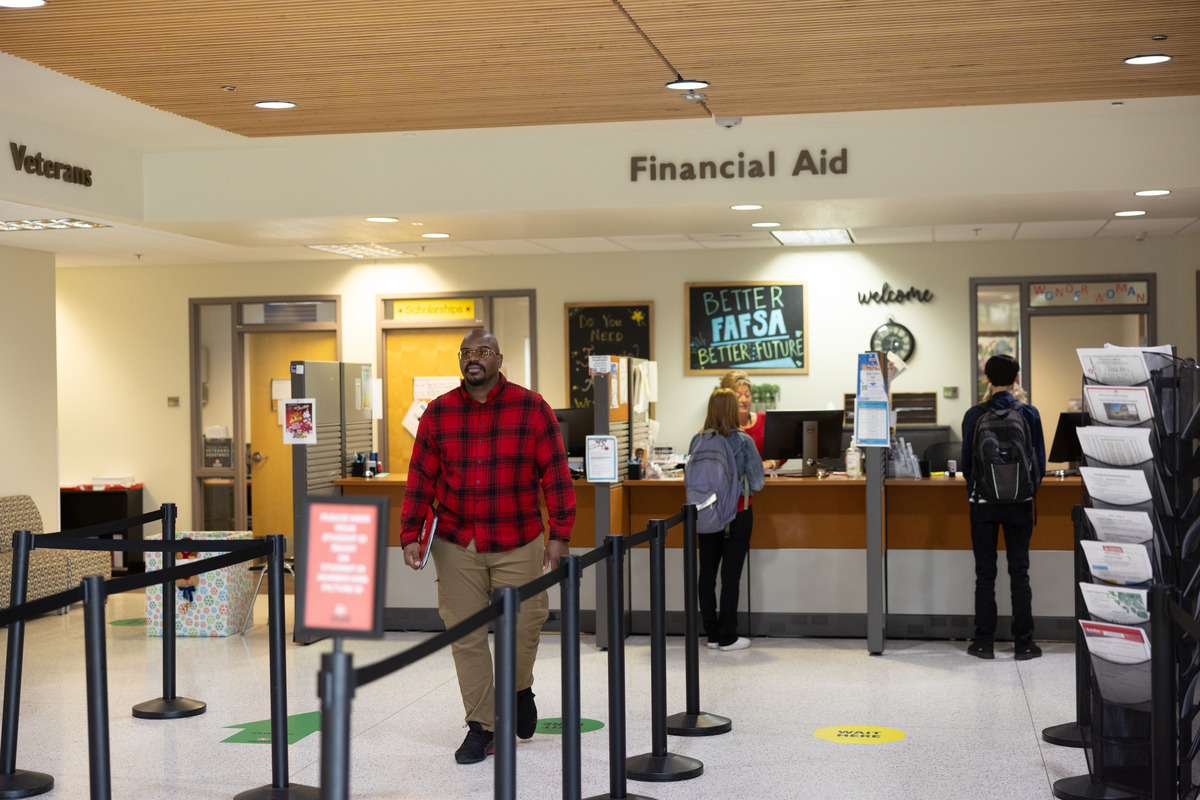Related Pages
Guiding you through Financial Aid at Cochise College.
First, find out the estimated cost for you to attend Cochise College. All students seeking financial aid and/or scholarships must fill out a FAFSA and follow the rules and procedures associated with it, including completing orientation and maintaining satisfactory progress.
Please take some time and read this: Important Financial Aid Steps (PDF)
Updates to FAFSA for 2024-2025
Great news for students! The FAFSA form is set to undergo updates in 2024-2025, promising a simplified process to make it easier than ever to secure the financial assistance you require for your education.
Gather These Documents
- Get your Federal Student Aid (FSA) User ID.
- Your new FSA ID is now used instead of your former Federal Student Aid PIN.
- How to Create an FSA ID (YouTube Video).
- Make sure you have your Social Security number
- For more information contact the Social Security Administration
- Your Driver’s License number, Citizenship Verification, or USCIS or Alien Registration number (the A# is not the same as your “Arrival” number).
- Your parents’ IRS Tax Returns (if you need a copy, request a transcript through the (IRS website) from the required tax year, and yours if you filed taxes.
- The online FAFSA also offers an IRS Data Retrieval Tool, to pull in your and/or your parent’s tax return data. Watch the IRS Data Retrieval Tool Tutorial (YouTube Video).
- If you or your parents earned income outside of the U.S., please note that income must also be reported at the current exchange rate.
- W-2 Forms and other records of money earned during the required tax year
- Current bank statements
The sooner you fill out your FAFSA, the better your chances are to get different kinds of Financial Aid. After all, the government budgets a limited amount of funds for Federal Student Aid, so don’t wait! FAFSA application periods are open from Oct. 1 of the previous school year through June 30 of the current school year.
Use the information below to determine which FAFSA(s) you should fill out with GCC’s Federal School Code (001076):
- FAFSA Year 2024/2025: Covers Fall 2024, Spring 2025 & Summer 2025. Requires Tax information from the 2022 year.
Need help? Check out the online tutorial video we have on this page. Visit the Federal Student Aid website from the Department of Education for more information and resources.
Avoid Scams! One thing FAFSA will never ask you for is money to pay; so if a website asks you to pay to either fill it out or submit it, you’re not working on the official FAFSA site. Be aware of other Financial Aid scams by reviewing the Department of Education’s Tips on Avoiding Scams.
Once you submit your FAFSA Application, it will take up to 5 business days for us to receive it from the Department of Education. You will also receive an email with your Student Aid Report; which will show your potential award, NOT your actual award. You will want to follow-up with the Financial Aid Office regarding your eligibility. In the meantime, you can work on getting admitted, meet with your Academic Advisor, and apply for Scholarships.
- Get your Federal Student Aid (FSA) User ID.
- Your new FSA ID is now used instead of your former Federal Student Aid PIN.
- How to Create an FSA ID (YouTube Video).
- Make sure you have your Social Security number
- For more information contact the Social Security Administration
- Your Driver’s License number, Citizenship Verification, or USCIS or Alien Registration number (the A# is not the same as your “Arrival” number).
- Your parents’ IRS Tax Returns (if you need a copy, request a transcript through the (IRS website) from the required tax year, and yours if you filed taxes.
- The online FAFSA also offers an IRS Data Retrieval Tool, to pull in your and/or your parent’s tax return data. Watch the IRS Data Retrieval Tool Tutorial (YouTube Video).
- If you or your parents earned income outside of the U.S., please note that income must also be reported at the current exchange rate.
- W-2 Forms and other records of money earned during the required tax year
- Current bank statements
The sooner you fill out your FAFSA, the better your chances are to get different kinds of Financial Aid. After all, the government budgets a limited amount of funds for Federal Student Aid, so don’t wait! FAFSA application periods are open from Oct. 1 of the previous school year through June 30 of the current school year.
Use the information below to determine which FAFSA(s) you should fill out with GCC’s Federal School Code (001076):
- FAFSA Year 2024/2025: Covers Fall 2024, Spring 2025 & Summer 2025. Requires Tax information from the 2022 year.
Need help? Check out the online tutorial video we have on this page. Visit the Federal Student Aid website from the Department of Education for more information and resources.
Avoid Scams! One thing FAFSA will never ask you for is money to pay; so if a website asks you to pay to either fill it out or submit it, you’re not working on the official FAFSA site. Be aware of other Financial Aid scams by reviewing the Department of Education’s Tips on Avoiding Scams.
Once you submit your FAFSA Application, it will take up to 5 business days for us to receive it from the Department of Education. You will also receive an email with your Student Aid Report; which will show your potential award, NOT your actual award. You will want to follow-up with the Financial Aid Office regarding your eligibility. In the meantime, you can work on getting admitted, meet with your Academic Advisor, and apply for Scholarships.
Steps to Apply
Expand All +Start the financial aid process by completing the Free Application for Federal Student Aid (FAFSA) at the FAFSA website. You may complete the form online (preferred) or by mailing it to the Department of Education (We do not recommend this option because it could add several weeks to the process). Students applying for federal financial aid must have earned their high school diploma or GED certificate.
To successfully complete your FAFSA application, you will need a copy of your or your contributor’s “PRIOR, PRIOR” taxes. A contributor is defined as a parent or spouse.
Cochise College’s school code is 001072.
Once a student receives their Student Aid Report (received after the completion of the FAFSA), it is the student’s responsibility to check with Financial Aid either through the MyCochise Portal, their student email for Financial Aid Tracking Letters, or by calling or emailing Financial Aid at 520-515-5417 / finaid@cochise.edu.
If your Financial Aid requirements are not complete, you will not receive a potential refund based on eligibility or be held in classes. All requested Financial Aid documentation must be submitted and processed for an award to be placed if you are eligible.
Students need to continually check their MyCochise and college email accounts throughout the year for any changes that could affect your financial aid. If you have questions, email them to financial aid from your college email account. Financial aid will not answer specific questions about your financial aid from any other email account.
Most often, this is all the information that we will need. Some FAFSA results are selected for verification. If you have been selected for verification, we will ask you to submit tax forms and complete a verification worksheet. We may need to ask for other information as well so that we can best help you through the verification process.
Award letters are found under Financial Aid within MyCochise. Awards are made by subtracting the student’s Expected Family Contribution from the student budget. Student budgets are an average based on the program of study, expected enrollment, and living arrangements. The following costs are included in each standard budget: tuition, fees, books, supplies, room, and board (students living with parents have board costs only), transportation, personal allowance, and loan fees. Some programs of study, such as nursing and aviation, may also have an additional allowance for lab fees, tools, flight time, etc. The following budget is an example for full-time students living off campus and registered in standard degree or certification programs. Budgets may vary from year to year.
Example budget:
Tuition and fees: $ 1,344
Books and supplies: $1,000
Room and board: $5,900
Transportation: $1,876
Personal expense: $1,350
Total:$11,470
Once the Expected Family Contribution is subtracted from the student budget, what is left is the unmet need. All financial aid is applied to the unmet need, with the goal of getting every student to zero unmet need. If a student’s unmet need reaches zero, no more federal aid can be granted.
All financial aid refunds are processed by the business office. Refunds are sent via Direct Deposit to your personal bank account on file or a paper check will be mailed to the address on file. The first refunds of the term will be produced for students who are registered for classes and have their aid award. These refunds, consisting of grant and scholarship funds, will be sent seven days before the start of the term. The next refunds will be processed and sent after the last date to add classes for the term. It is your responsibility to make sure that your direct deposit information and current mailing address is on file. Address changes should be submitted to the Admissions Office or the Records and Registration Office. Questions regarding your award amount should be addressed to the Financial Aid Office. The disbursement date seen on MyCochise portal is only an estimated date; it is not the date students will receive refunds.
You may ask for a hard copy of your tracking, award, or non-satisfactory progress letter by emailing finaid@cochise.edu and telling us which letter you are requesting, your name, student ID number (C number) and your current address. Allow 48 hours for processing and then mailing time.
The Department of Education selects one out of every three students who complete the FAFSA for verification. If you are selected for verification, you will be asked for the following documents:
- a signed copy of your federal income tax return
- a copy of your parents’ federal tax return if you are a dependent student
- a completed verification worksheet
Documentation of untaxed income will be required. If corrections are required, the Financial Aid Office will submit them electronically or ask the student to make the corrections online. Expect processing to be delayed approximately three weeks. All items reported on the FAFSA are verifiable. Financial aid may ask for additional documents throughout the academic year.
Student Financial Aid Rights
The information provided to the Financial Aid Department is confidential as mandated by the Family Educational Rights and Privacy Act (FERPA).
You have the right to:
- Request personal assistance if you have questions or don’t understand the Financial Aid information and/or forms provided to you.
- To know what Financial Aid assistance is available; to include all Federal and Institutional aid programs.
- To know the procedures and Deadlines for each Financial Aid programs, including all available scholarships.
- To know how your Financial Aid Awards (policy 4015) were calculated, what the criteria to receive each award, and how the funds will be dispersed.
- To accept or decline any Financial Aid award that is granted.
- To know the lender, interest rates, the total amount to be repaid, deferment options, repayment procedures and when payments begin when requesting an Educational Loan (PDF).
- To submit a Special Circumstances Appeal when requesting reconsideration of your household’s Financial Aid eligibility and ability to pay for school if you or your *contributor’s circumstances change. (*Contributor is defined as defined as a parent or spouse)
- To know what happens if you Withdraw or Stop (PDF) attending one or all of your classes.
- To submit a Non-Satisfactory Progress Appeal (PDF) if you do not meet the academic standards when receiving aid.
You have the right to know Cochise College’s policy and standard operating procedure regarding Return to Title IV (PDF).
Student Responsibilities
As a student receiving Financial Aid at Cochise College, you are responsible for:
- Providing accurate information to the Financial Aid Department.
- Completing the FAFSA application accurately and submitting it on time. Errors can delay the process and impact your Financial Aid.
- Reading and understanding all materials provided to you, and all forms that you may be required to complete and sign from the Financial Aid Department.
- Requesting personal assistance if you have questions or don’t understand the information provided to you.
- Submitting documentation and information requested by the Financial Aid Department in a timely manner and keeping copies for your own records.
- Checking your Cochise College portal account and student email regularly.
- Notifying Cochise College of any name and address changes. Holds can be placed on a student’s account preventing registration if an address or name is not updated.
- Notifying the Financial Aid Department if you change your enrollment status.
- Knowing and complying with the rules governing your Financial Aid award(s). Log into your MyCochise account to view your financial aid award(s).
- Attending classes and completing the requirements for each enrolled class.
- Complying with Cochise College’s refund policy (PDF) and federal Return to Title IV Policy (PDF), should you withdraw or stop attending from the college either officially or unofficially.
- For completing a Master Promissory Note (Website) and the Entrance Counseling (Website) if you are requesting a Direct Stafford Loan. In addition, you are responsible for completing the Exit Counseling (Website) when you graduate, withdraw or enroll in 5 or fewer credits.
- Notifying your Direct Loan Lender of any name, address, telephone, email and school status.
- Repayments of all loans in accordance with the terms of the Master Promissory Note (Website).
- Maintaining Satisfactory Academic Progress (PDF), and attending and passing your classes in order to continue to be eligible for Financial Aid. If you require assistance there is tutoring or counseling available to all students.
- Notifying the Financial Aid Department of any financial awards you receive from outside resources, (including scholarships, Veteran’s benefits, tuition waivers or other educational/tuition assistance) not already listed on your Financial Aid Award Letter.
Repayment for any over award. If there is ever an over award of any Financial Aid, the student is responsible for repayment in a timely manner.
Policies & Deadlines
Each year’s freeze dates are listed in the Financial Aid calendar of the Academic Calendar.
A student receiving financial aid must be registered in all classes for the semester by the listed freeze date. For example, if you are registering for full 16-week and/or first 8-week classes, you cannot add another second 8-week class after the posted freeze date. Any classes added after the freeze date will not be eligible for financial aid during that semester. If you are registering for only the second 8-week session, the freeze date will be the posted last-date-to-add for the second 8-week term.
Fall & Spring: First day of registration through 30 days prior to the end of the semester.
Fall Only: First day of registration through 30 days prior to the end of the fall semester.
Spring Only: First day of registration through 30 days prior to the end of the spring semester.
Summer Session: First day of registration for summer through the second week of June.
Each year’s freeze dates are listed in the Financial Aid calendar of the Academic Calendar.
A student receiving financial aid must be registered in all classes for the semester by the listed freeze date. For example, if you are registering for full 16-week and/or first 8-week classes, you cannot add another second 8-week class after the posted freeze date. Any classes added after the freeze date will not be eligible for financial aid during that semester. If you are registering for only the second 8-week session, the freeze date will be the posted last-date-to-add for the second 8-week term.
Fall & Spring: First day of registration through 30 days prior to the end of the semester.
Fall Only: First day of registration through 30 days prior to the end of the fall semester.
Spring Only: First day of registration through 30 days prior to the end of the spring semester.
Summer Session: First day of registration for summer through the second week of June.
Grants & Loans
Grants are financial aid that don’t have to be repaid. Grants are often need-based and can come from the federal government, state government, college or career school, or a private or nonprofit organization.
The Pell Grant is awarded to traditional and nontraditional undergraduate students who have not earned a bachelor’s or professional degree. Eligibility is based on information provided on your FAFSA, as well as your enrollment status. The U.S. Department of Education guarantees that each participating school will receive enough funding to pay the grants to all its eligible students. The Pell Grant does not have to be repaid.
The consolidated Appropriations Act, 2012 (Public Law 112‐74) significantly impacted the Federal Pell Grant Program. Students are now limited to 12 semesters (or 600%) of Federal Pell Grant eligibility during their lifetime. This change affects all students, regardless of when or where they received their first Federal Pell Grant.
If you have attended college for four years or longer and received the Federal Pell Grant each semester of attendance, you are likely to exhaust or have already exhausted your lifetime limit of 12 semesters of Federal Pell Grant eligibility during the 2020‐21 school year. If you have attended college for three years or less and received the Federal Pell Grant each semester of attendance, you will likely not surpass the lifetime limit during the 2020‐21 school year. Whether you have used all of your Federal Pell Grant eligibility or only half, be conscious about the lifetime limit of the Federal Pell Grant when changing majors and/or scheduling classes.
The percentages are based off of the annual award at full‐time enrollment status. For example:
- A student attending in the academic year 2022‐2023 at full time status and receiving their maximum annual award, the percentage used for 2022‐2023 is 100%.
- If the student attends only 9 credits (3/4 time) for each semester, the percentage used is 75%.
- If the student attends only 6 credits (1/2 time) for each semester, the percentage used is 50%.
You can find your Lifetime Eligibility Used for the Federal Pell Grant by visiting the National Student Loan Data System for Students website (NSLDS) and creating a student account. The National Student Loan Data System tracks your lifetime Pell Grants, loan usage and overpayment status. If you have loans, you may also view how much you owe and to whom.
- Step 1: Create an FSA ID. Students and parents are required to use an FSA ID, made up of a username and password, to submit their FAFSA form online and to access sensitive information on the U.S. Department of Education Websites. Your FSA ID is used to confirm your identity and electronically sign your federal student aid documents. Your FSA ID has the same legal status as a written signature. You can obtain an FSA ID on the FAFSA website by clicking Create an FSA ID on the login page.
- Step 2: Access the NSLDS website and click Financial Aid Review
- Step 3: Read the privacy statement on this screen. If you agree, click Accept to find your Lifetime Eligibility Used. A security configuration question may or may not prompt depending on your browser’s security configuration. If you are comfortable with your browser’s current security configuration, click Accept to continue. The Confirming Your Identity screen will appear after you click Accept.
- Step 4: Enter your Social Security number (SSN), the first two letters of your last name, your date of birth, and your PIN to confirm your identity.
- Step 5: View the Financial Aid Review screen listing your total Lifetime Eligibility Used.
For additional information on Pell Grant Lifetime Eligibility contact ‐ Federal Student Aid Information Center (FSAIC), call 1‐800‐4‐FED‐AID (1‐800‐433‐3243).
College does not automatically award student loans. Students must notify the Financial Aid Office of their need for student loans.
Official Cohort Default Rate Information
The U.S. Department of Education (the Department) publishes cohort default rates based
on the percentage of a school’s borrowers who enter repayment on Direct Loan Program
loans during a federal fiscal year (October 1–September 30) and default before the
end of the second following fiscal year.
Cochise College’s rates:
2020 0
2019 2.9
2018 4.9
Student Loan Steps
- Request a loan from Cochise College Financial Aid.
- Be processed for financial aid at Cochise College.
- Be enrolled in at least six credits. We will certify current enrollment, satisfactory progress and verify that you do not have any other student loans in default. You must maintain at least half-time enrollment throughout the loan period to receive the funds. If you enroll in fewer credits than you originally planned, your loan eligibility may be reduced.
Loans may be subsidized or unsubsidized and are available to eligible undergraduate students. Eligible students may receive both subsidized and unsubsidized loans for the same enrollment periods. All students requesting loans must complete an Entrance Counseling and a Master Promissory Note at the government student loans website.
A subsidized direct loan is awarded on the basis of financial need. Interest will not be charged before repayment begins or during authorized periods of deferment. The federal government subsidizes the interest during these periods. You must complete a master promissory note, every year, in order to receive loan funds. First time Government Student Loan borrowers or if it has been more than 10 years since you completed an Entrance Counseling Interview, then you will need to complete a new Entrance Counseling Interview before the loan is processed.
Federal Subsidized Student Loan Limit
First-time borrowers taking out federal Direct Subsidized loans on or after July 1, 2013 are subject to the 150% Direct Subsidized Loan Limit, which limits the amount of time a student is eligible to borrow subsidized loans to 150% of their published program length. This means that the actual time limit on your borrowing of subsidized loans varies based on the length of your program.
For example:
2 YEAR ASSOCIATE 3 YEAR LIMIT
1 YEAR CERTIFICATE 1.5 YEAR LIMIT
If you change your major, your limit may change as well, if this happens, the subsidized loans you received in your previous program usually count against your new maximum eligibility period.
If you reach the subsidy limit, you are no longer eligible to take out any more subsidized loans. However, this does not affect your eligibility for unsubsidized loans.
The interest on your existing subsidized loans is no longer subsidized by the government when you’re in school, a deferment, or in certain income-driven repayment plans. This means you are responsible for ALL interest that accrues on your subsidized loans moving forward.
An unsubsidized Direct loan is not awarded on the basis of need. Interest is charged from the time the loan is disbursed until it is paid in full. Students may choose to pay interest while still in school and pay less interest in the long run. If interest is not paid, it is capitalized – that is, the interest is added to the principal balance of the loan(s) and additional interest is then based upon the higher amount. This increases the amount that must be repaid. Interest rates are fixed (adjusted annually) but will not exceed 6.53 percent. You must complete a master promissory note, every year, in order to receive loan funds. A loan must be repaid. First time Government Student Loan borrowers or if it has been more than 10 years since you completed an Entrance Counseling Interview, then you will need to complete a new Entrance Counseling Interview before the loan is processed.
PLUS loans enable parents to borrow to pay the educational expenses of each child who is a dependent undergraduate student enrolled at least half time (six credit hours per semester). PLUS loans are credit contingent. Interest rates are fixed(adjusted annually) but by law will not exceed 9.08 percent. PLUS loan payments begin 60 days after the loan has been disbursed. A parent must complete the application and promissory note for the federal PLUS loan. First time Government Student Loan borrowers or if it has been more than 10 years since you completed an Entrance Counseling Interview, then you will need to complete a new Entrance Counseling Interview before the loan is processed.
Grants are financial aid that don’t have to be repaid. Grants are often need-based and can come from the federal government, state government, college or career school, or a private or nonprofit organization.
The Pell Grant is awarded to traditional and nontraditional undergraduate students who have not earned a bachelor’s or professional degree. Eligibility is based on information provided on your FAFSA, as well as your enrollment status. The U.S. Department of Education guarantees that each participating school will receive enough funding to pay the grants to all its eligible students. The Pell Grant does not have to be repaid.
The consolidated Appropriations Act, 2012 (Public Law 112‐74) significantly impacted the Federal Pell Grant Program. Students are now limited to 12 semesters (or 600%) of Federal Pell Grant eligibility during their lifetime. This change affects all students, regardless of when or where they received their first Federal Pell Grant.
If you have attended college for four years or longer and received the Federal Pell Grant each semester of attendance, you are likely to exhaust or have already exhausted your lifetime limit of 12 semesters of Federal Pell Grant eligibility during the 2020‐21 school year. If you have attended college for three years or less and received the Federal Pell Grant each semester of attendance, you will likely not surpass the lifetime limit during the 2020‐21 school year. Whether you have used all of your Federal Pell Grant eligibility or only half, be conscious about the lifetime limit of the Federal Pell Grant when changing majors and/or scheduling classes.
The percentages are based off of the annual award at full‐time enrollment status. For example:
- A student attending in the academic year 2022‐2023 at full time status and receiving their maximum annual award, the percentage used for 2022‐2023 is 100%.
- If the student attends only 9 credits (3/4 time) for each semester, the percentage used is 75%.
- If the student attends only 6 credits (1/2 time) for each semester, the percentage used is 50%.
You can find your Lifetime Eligibility Used for the Federal Pell Grant by visiting the National Student Loan Data System for Students website (NSLDS) and creating a student account. The National Student Loan Data System tracks your lifetime Pell Grants, loan usage and overpayment status. If you have loans, you may also view how much you owe and to whom.
- Step 1: Create an FSA ID. Students and parents are required to use an FSA ID, made up of a username and password, to submit their FAFSA form online and to access sensitive information on the U.S. Department of Education Websites. Your FSA ID is used to confirm your identity and electronically sign your federal student aid documents. Your FSA ID has the same legal status as a written signature. You can obtain an FSA ID on the FAFSA website by clicking Create an FSA ID on the login page.
- Step 2: Access the NSLDS website and click Financial Aid Review
- Step 3: Read the privacy statement on this screen. If you agree, click Accept to find your Lifetime Eligibility Used. A security configuration question may or may not prompt depending on your browser’s security configuration. If you are comfortable with your browser’s current security configuration, click Accept to continue. The Confirming Your Identity screen will appear after you click Accept.
- Step 4: Enter your Social Security number (SSN), the first two letters of your last name, your date of birth, and your PIN to confirm your identity.
- Step 5: View the Financial Aid Review screen listing your total Lifetime Eligibility Used.
For additional information on Pell Grant Lifetime Eligibility contact ‐ Federal Student Aid Information Center (FSAIC), call 1‐800‐4‐FED‐AID (1‐800‐433‐3243).
College does not automatically award student loans. Students must notify the Financial Aid Office of their need for student loans.
Official Cohort Default Rate Information
The U.S. Department of Education (the Department) publishes cohort default rates based
on the percentage of a school’s borrowers who enter repayment on Direct Loan Program
loans during a federal fiscal year (October 1–September 30) and default before the
end of the second following fiscal year.
Cochise College’s rates:
2020 0
2019 2.9
2018 4.9
Student Loan Steps
- Request a loan from Cochise College Financial Aid.
- Be processed for financial aid at Cochise College.
- Be enrolled in at least six credits. We will certify current enrollment, satisfactory progress and verify that you do not have any other student loans in default. You must maintain at least half-time enrollment throughout the loan period to receive the funds. If you enroll in fewer credits than you originally planned, your loan eligibility may be reduced.
Loans may be subsidized or unsubsidized and are available to eligible undergraduate students. Eligible students may receive both subsidized and unsubsidized loans for the same enrollment periods. All students requesting loans must complete an Entrance Counseling and a Master Promissory Note at the government student loans website.
A subsidized direct loan is awarded on the basis of financial need. Interest will not be charged before repayment begins or during authorized periods of deferment. The federal government subsidizes the interest during these periods. You must complete a master promissory note, every year, in order to receive loan funds. First time Government Student Loan borrowers or if it has been more than 10 years since you completed an Entrance Counseling Interview, then you will need to complete a new Entrance Counseling Interview before the loan is processed.
Federal Subsidized Student Loan Limit
First-time borrowers taking out federal Direct Subsidized loans on or after July 1, 2013 are subject to the 150% Direct Subsidized Loan Limit, which limits the amount of time a student is eligible to borrow subsidized loans to 150% of their published program length. This means that the actual time limit on your borrowing of subsidized loans varies based on the length of your program.
For example:
2 YEAR ASSOCIATE 3 YEAR LIMIT
1 YEAR CERTIFICATE 1.5 YEAR LIMIT
If you change your major, your limit may change as well, if this happens, the subsidized loans you received in your previous program usually count against your new maximum eligibility period.
If you reach the subsidy limit, you are no longer eligible to take out any more subsidized loans. However, this does not affect your eligibility for unsubsidized loans.
The interest on your existing subsidized loans is no longer subsidized by the government when you’re in school, a deferment, or in certain income-driven repayment plans. This means you are responsible for ALL interest that accrues on your subsidized loans moving forward.
An unsubsidized Direct loan is not awarded on the basis of need. Interest is charged from the time the loan is disbursed until it is paid in full. Students may choose to pay interest while still in school and pay less interest in the long run. If interest is not paid, it is capitalized – that is, the interest is added to the principal balance of the loan(s) and additional interest is then based upon the higher amount. This increases the amount that must be repaid. Interest rates are fixed (adjusted annually) but will not exceed 6.53 percent. You must complete a master promissory note, every year, in order to receive loan funds. A loan must be repaid. First time Government Student Loan borrowers or if it has been more than 10 years since you completed an Entrance Counseling Interview, then you will need to complete a new Entrance Counseling Interview before the loan is processed.
PLUS loans enable parents to borrow to pay the educational expenses of each child who is a dependent undergraduate student enrolled at least half time (six credit hours per semester). PLUS loans are credit contingent. Interest rates are fixed(adjusted annually) but by law will not exceed 9.08 percent. PLUS loan payments begin 60 days after the loan has been disbursed. A parent must complete the application and promissory note for the federal PLUS loan. First time Government Student Loan borrowers or if it has been more than 10 years since you completed an Entrance Counseling Interview, then you will need to complete a new Entrance Counseling Interview before the loan is processed.
Contact Information
|
Director of Financial Aid |
Sierra Vista Campus |
Douglas Campus |
Fax Number |






